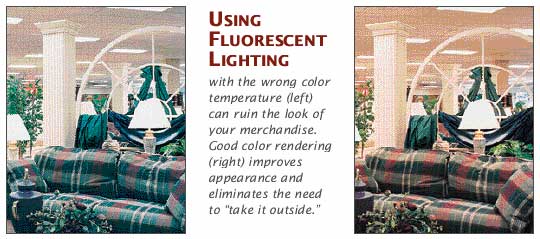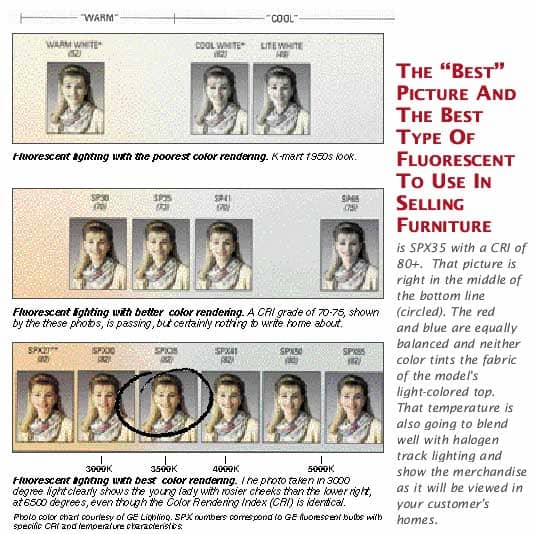Part 2: Lighting with right CRI and temperature can boost sales... the wrong choice can make your store look like the corner grocery.
Editor's note: the April/May 2001 issue of FURNITURE WORLD Magazine, contributing editor Monte Lee explained how FURNITURE WORLD readers can improve the lighting quality in their stores, while simultaneously lowering operating costs. His article (posted to the operations management article index on www.furninfo.com) also explained how to perform an after hours store lighting survey and provided helpful hints on using track lighting, incandescent, fluorescent and halogen bulbs. This long awaited follow-up piece looks at fluorescent lighting in more detail. A future article will address specifics of energy efficiency, costs and heat generation.
The two questions about lighting that furniture retailers ask most often are, “Can I use fluorescent light in my store?” followed quickly by, “What should I use?” There's a simple answer to both questions.
The simple answer is, “Yes, 3500 degree color temperature and at least 80 CRI.” but most retailers want to know “Why?” They want to know the reasons behind the short answer to overcome fears, uncertainty, and doubts. Sound familiar?
Other questions come up during the explanation about who uses fluorescent and how it is used. Almost every category in furniture retailing, from promotional to high-end, uses fluorescent lighting to some extent. The mix between fluorescent and other sources will vary according to price points but the list is extensive and ranges from Ashley to Thomasville. You can see other examples during a trip to the mall.
Oak Hollow Mall More than Parking?
The challenge of trying to explain lighting and color is to show you what I mean so you can understand the concepts. Maybe we have common ground if you have used Oak Hollow Mall for something besides parking during the High Point Furniture show. If not, check out your local mall.

Stores like The Limited, Victoria's Secret and Express rely entirely on halogen lighting. Belk, Dillard, Sears and Penny use a combination of fluorescent and halogen but the newest store, Joseph Banks, uses only fluorescent. I think you will agree that the “look” achieved by either Express or Banks is entirely appropriate for retailing.
Next time you pick up market munchies at the High Point Harris-Teeter, take a look at their produce department. Fluorescent lighting is used to bring out the color of fresh fruits and vegetables. Why? More vibrant color means more sales. Using fluorescent lighting to improve color for men's clothing and apples seems to go against the “conventional wisdom.” As usual, conventional wisdom is out of step with reality or at least lighting technology.
A Picture and a Thousand Words
You won't find many photographers using fluorescent light to set their subjects but, as you can see by Figure 1, one did. I'm thankful he did because that graphic is the best explanation of the relationship between “color rendering” and “color temperature” I have seen. Pick your favorite picture. Which one looks “best” to you?
Chances are your favorite picture was not in the top row. The top row shows fluorescent light with the poorest color rendering. These are the tubes you get at hardware stores for a buck. They are cheap because they don't have much of the “white stuff” that makes a fluorescent generate “good light.” The lighting effect of cheap bulbs is a “K-Mart-of-the-60's” look, a prescription for failure.
As you move toward the bottom of the figure, colors become more vibrant, richer, and closer to what we perceive as “true color.” Simply put, the white stuff in the fluorescent tube is better quality, there is more of it and the appearance of color improves accordingly. The white stuff isn't free so the cost of the tube increases with each improvement in color rendering.
The cost of good color really isn't worth thinking about. I mentioned the cost of a fluorescent with bad color rendering is a buck. Something in the middle costs $2.00 and the best is $3.00 delivered to your store. Fluorescents last four to five years so we are talking about nothing in terms of cost to have good color rendering, even if you have hundreds of them.
Note that the chart (below) may not be adequate for color comparison purposes.

Color Rendering
Color rendering is an important concept to understand for lighting of any type. The ability of a light source to accurately present color is stated as a numeric value from 0 to 100. Color Rendering Index, or CRI, is a common abbreviation in lighting. Think of CRI as a grade, like the ones we got in school. Clearly CRI in the 49-52 range (top of Figure above) is not a passing grade for displaying furniture or anything else.
The color we see is a combination of two things, color in the object we are looking at and color present in the light source. In fact, we really don't see sofas and chairs we see light reflecting from them. The color we see is influenced by the balance (or lack of balance) among the three primary colors, red, green and blue. Our brain won't recognize a color if the light source does not contain it, regardless of the colors present in the object.
You may notice cities are replacing orange streetlights with white ones. The orange lamps are sodium, another type of “gaseous discharge” lighting like fluorescents. The color rendering of sodium streetlights was so poor, a CRI of 20-25, that police couldn't get accurate descriptions from crime scene witnesses. The sodium lamps were replaced. Similarly, “cool white” fluorescents have no place on furniture sales floors.
A grade of 70-75, shown by the middle group of pictures, is passing, but certainly nothing to write home about. Clearly the “best” color rendering is the bottom group of pictures. But there are still differences in the way color appears even among the best. The difference between the pictures at the left and right of the illustration is due to variation in color temperature, the second variable in making colors look right.
Color Temperature
The “fine print” on color rendering deals with color temperature. In theory, you can only compare CRI of lamps with the same color temperature. That means that colors under an “excellent” lamp at 3000 degrees will look different from colors under an excellent lamp with a temperature of 6500 degrees. You can see that point by comparing the lower left and right images.
The lower left, 3000 degrees, clearly shows the young lady with rosier cheeks than the lower right, 6500 degrees, even though the CRI is identical. The reason is that the color rendering index is actually an average of the light source's ability to render eight colors. If the bulb gets a low mark on blue tones but high marks on red, and the average is 82 (SPX27). The exact opposite is true for the SPX65 image in the lower right but the average is still 82.
I cringe when a sales associate in a furniture store says, “Here, take this pillow outside so you can see the “true color.” That may be a good strategy for patio furniture that will be used in the sun but it makes no sense for furniture that will be used in a living room. Good color rendering belongs in your showroom not in the parking lot.
Natural light does have a CRI of 100, perfect score, so there is some logic to “taking it outside.” The color temperature of natural light varies significantly during the day so the apparent color of objects in natural light will vary as well. Noonday sun, depending on where you live, will have a color temperature of about 5000 degrees. The incandescents in my living room also have a CRI of 100 but at a temperature of 2700 degrees. Since I only see my furniture at night with incandescent lighting, looking at colors outside, in sunlight is not really productive.
My pick for the “best” picture and the best type of fluorescent to use in selling furniture is SPX35 with a CRI of 80+. That picture is right in the middle of the bottom line. The red and blue are equally balanced and neither color tints the fabric of the model's light-colored top. That temperature is also going to blend well with halogen track lighting. That combination of lighting will show the merchandise as I will use it, inside my house.
Exactly Imprecise
If you have kept track of the numbers there may seem to be a disconnect in what you thought I said. My living room has 2700 degrees, halogen is nominally 3000 degrees and I recommend 3500 degrees for fluorescent color temperature. One could assume all the numbers would be equal and probably 2700.
The fact is the numbers for fluorescent aren't as precise as we may be led to believe. The concept of “color temperature” is based on heating iron like the village blacksmith. The iron starts to turn red and eventually gets “white hot.” Color temperature of incandescent light, including halogen, can be measured according to that scale because their filaments are heated just like horseshoes.
Your local bulbman has probably tried to sell you “color correlated” fluorescents said to be great for furniture. The fact is fluorescents don't generate light by heating a filament and have to be “correlated” to the temperature scale. The “correlated color temperature” is an approximation for all fluorescents and nothing new or special. The second fact is the industry scale allows for differences in manufacturing processes such that a fluorescent need not be precisely 3500 degrees to be classed as such as long as it falls within a range of values established as the standard. We could have a fluorescent from manufacturer “A” at 3000 degrees and really not be able to see the difference between that and a 3500-degree product from manufacturer “B.”
There is indeed a human part of the color equation that takes the color of the object, the wavelengths or color present in the light source, and processes the information so we can perceive the color in our brains. The color you see may be different from mine and you see the results of that concept in “like it-don't like it” discussions on the sales floor. It is all exactly imprecise.
Humans also respond to wavelengths in the light source. We light hotels and restaurants with 2700 degrees and offices with 4100 degrees. The idea is humans are more active where the wavelengths are more like daylight. If you want your customers to be relaxed and cozy use 2700-degree fluorescents. If you want them to buy furniture my answer is 3500.
Fluorescent light is my favorite background light in furniture showrooms. Fluorescent fixtures have the ability to generate a lot of light with comparatively little electricity if you are using the right fixture. (Energy efficiency is the topic of the next article in this series.) If you are using the right fixtures you are also getting long service life, as much as 20,000 hours, and good color rendering. That last point, color rendering, is the most important one. In this business it’s all about color.
Monte Lee is a Regional Manager for Service Lamp Corporation, a
distributor of lighting products and services. Inquiries on any aspect of furniture store lighting can be sent to him at mlee@furninfo.com